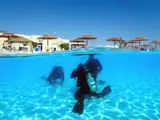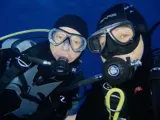How to be safe while diving or snorkeling in the Red Sea
If you plan to go snorkeling or scuba diving in the Red Sea in Egypt, it is good to know what inhabits the coral reefs, what lives in the sea, what animals can be dangerous and how to behave in the water. Be considerate and informed, and the probability that any of the animals will harm you in the water is negligible. Most animals are shy. You have a much higher chance of getting sunburned while snorkeling.
How to behave in the Red Sea:
- swim along the reef not over it, reefs usually reach just below the surface
- don't touch anything, don't step on the coral reef
- do not feed the fish, you will disturb the biological balance
- do not throw garbage into the sea
- do not collect seashells, usually some animal lives inside
- do not collect other animals, do not break corals
- do not disturb or touch the underwater animals
- if an aggressive fish swims towards you, leave its territory
- if you're taking pictures or video, don't chase fish, watch where you're swimming
- don't go snorkeling and of course don't dive alone
- if entering the water from shore, wear water shoes
- if you go snorkeling, wear a lycra t-shirt or a light wetsuit, for example
- do not enter the water at night
- check in advance for local conditions
Let's compare what dangers we face in Egypt in the sea and in Europe, for example, in the forest. When you go to the forest, you know what awaits you there. You may squirm on nettles, you may be stung by a wasp, you may be bitten by a tick, or you may see a viper basking on a stone. You know the forest and you know what to do when something happens and you know what prevention is. The fact is that there are stinging organisms in nature, animals that can bite you or have poisonous spines.
Bites and cuts
There is a simple answer to the question of why some fish behave aggressively. It defends its territory, for example the clownfish its anemone or the surgeonfish a piece of reef that brings it sustenance. Some fish protect their clutch of eggs, for example the triggerfish, which defend their nest in the summer - a funnel dug in the sand, and chase away anyone who gets too close. Most of these fish warn intruders before attacking, usually swimming quickly past. It follows that he should preferably move away in a horizontal direction. Then the risk of harm is minimal.
Usual first aid: disinfection, possibly cover the wound, if necessary, a visit to the doctor
Sting with a poison barb
Animals that have poisonous spines also live in the Red Sea. They are lionfish, scorpionfish, stonefish or stingrays as well as sea urchins. They use the spines for their defense, of course. The fish will not attack you by itself. If you go into the water from the beach, it is better to wear water shoes. You can also, for example, step on a sharp stone. If you are swimming around a coral reef, keep a safe distance and do not reach or climb on the reef. This is mainly for the reason that you do not damage the coral reef!
Usual first aid: the warmest possible water, painkillers if needed, see a doctor
Incitement (burnt)
Among the stinging animals we can find in the Red Sea, for example, so caled fire coral, which will cause you an unpleasant, long-healing red rash. Again, don't touch anything and keep a reasonable distance. Remember that corals do not grow as fast as nettles. As for other stinging animals, such as jellyfish, the species found here are not very dangerous. Sometimes it happens that something small, stinging plankton, rubs against you, but it's no worse than an ant bite.
The usual first aid: lemon or vinegar, if necessary, a visit to the doctor
Sharks
There is talk of the danger posed by sharks in the Red Sea. Although with them on the coral reefs around Hurghada we do not meet very often, in the Red Sea there are species that are considered dangerous (longfin shark, tiger shark or mako). Such types of sharks are most often found near reefs, where the wall falls to great depths and there are usually stronger currents. In Hurghada there are shallows near the shore, deeper walls can be found up to a few kilometers away beyond Giftun Island and further in the open sea. In the Egyptian part of the Red Sea, there is no known case of a shark killing a scuba diver. As for swimmers or snorkelers, the thing is that they can mistake some species of sharks that also hunt close to the surface for their usual food, especially if the swimmer moves quickly, with jerky movements. Sharks usually attack moving from down to up. If you happen to see a shark, it is recommended to follow it and slowly move away. The probability that a shark attacks you is really small. The unfortunate incident that occurred recently in Hurghada does not affect diving or snorkeling at the reefs around Hurghada now.
What to do, if you as a diver meet a shark: stay close to the reef in the group of divers, keep vertical possition, like this you look bigger.
Read more about tiger sharks.
Waves and currents
People often do not realize that there can be currents in the sea or that being on the surface can be made uncomfortable by waves. It is best to check the conditions in advance at the location, for example at the local diving center. If you swim out into the open sea from the sheltered bay, you have no chance of going ashore over the coral reef at any time. You need to figure out where to return and how far you can afford to swim.
Treat the Red Sea coral reefs and their inhabitants with respect. There is a greater chance that a person will harm the reef than the other way around. Get informed and follow the rules. And then "those who are afraid are not allowed in the forest" ;-).
See also: Dangerous animals of the Red Sea




















About the author
Pavla